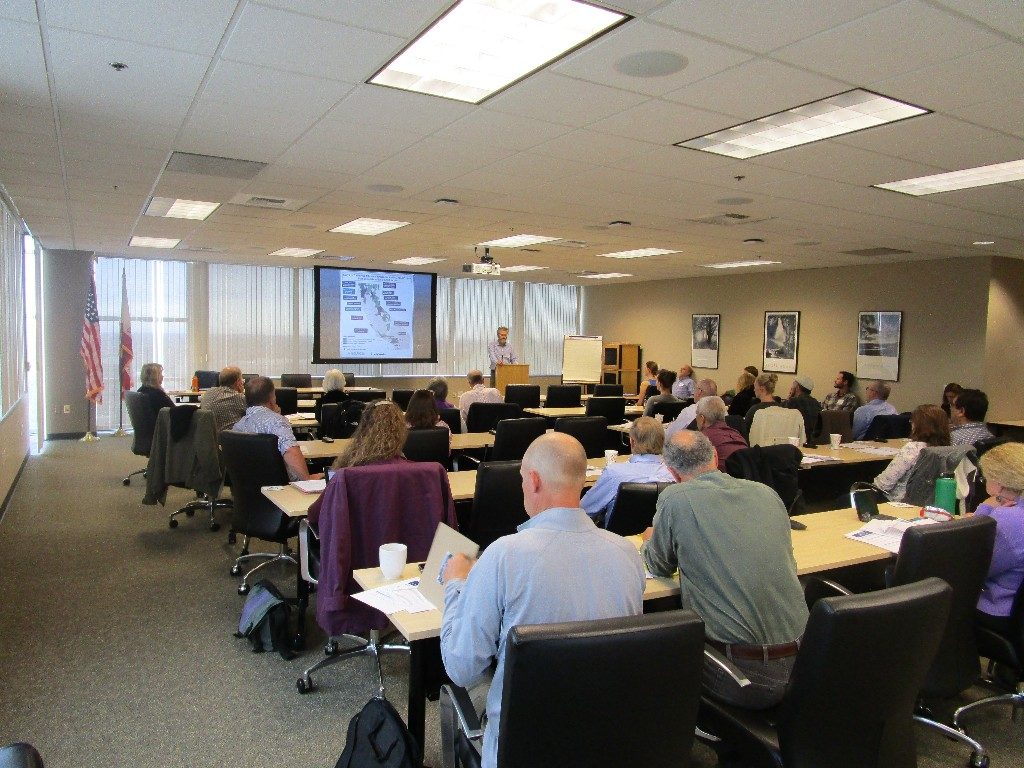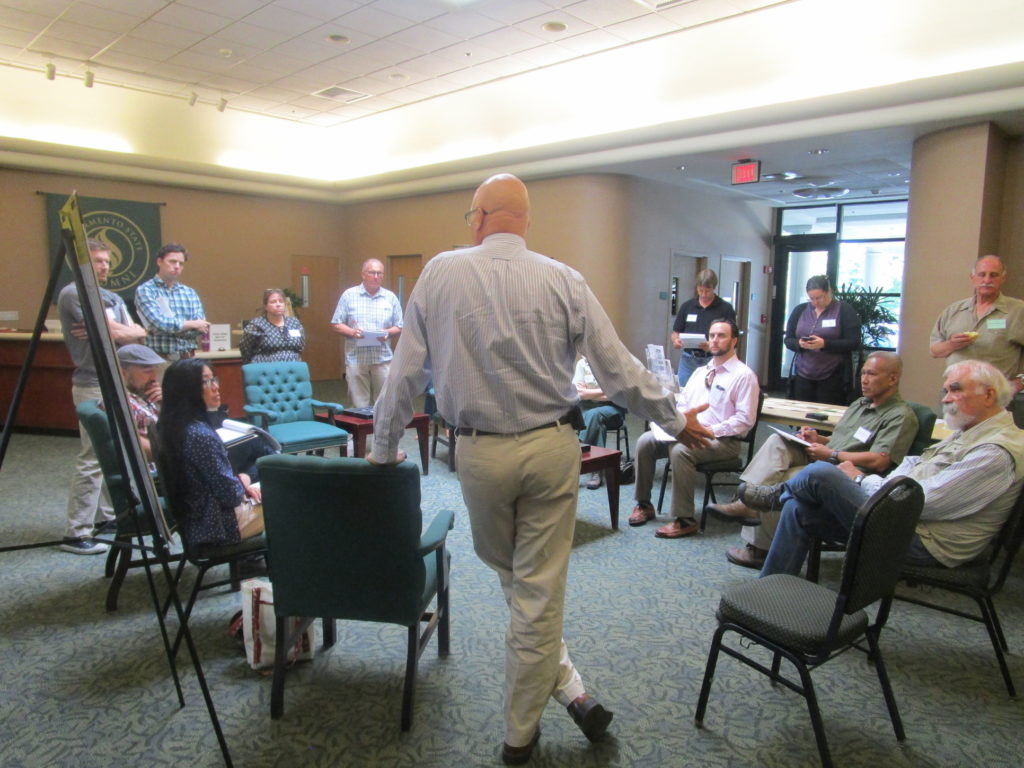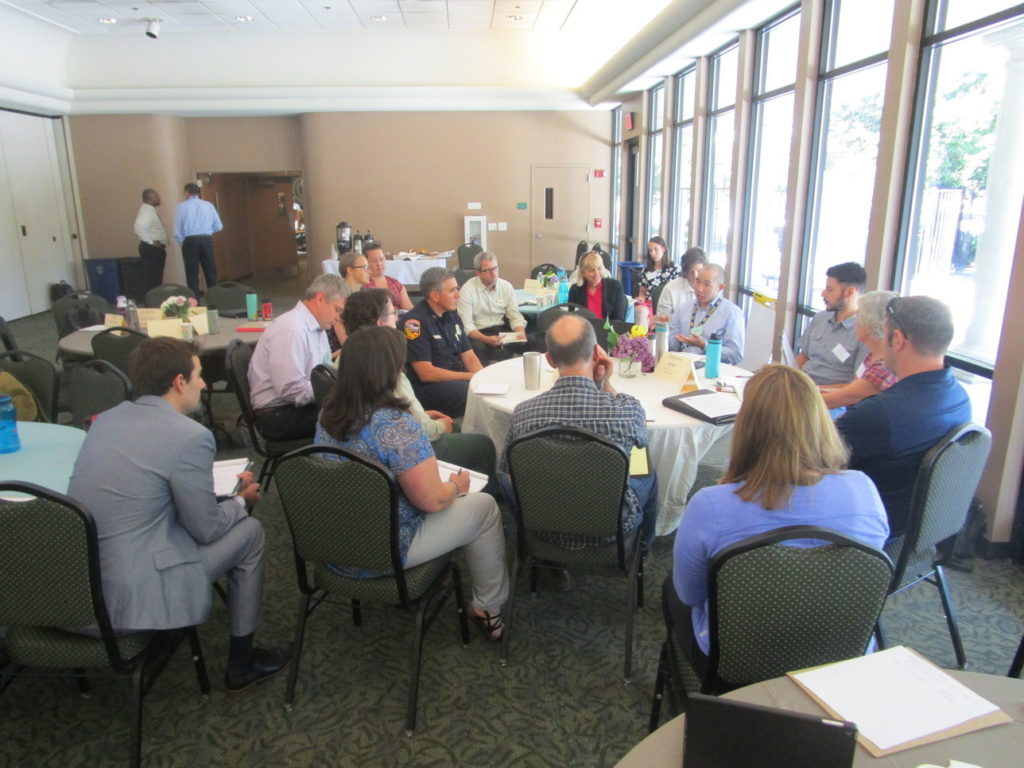The Sierra Institute recently released a storymap depicting our biomass projects. The story makes the case for biomass utilization by providing a background on wildfire, tree mortality, active forest management, mill closures, and rural economies today. View the storymap by clicking the thumbnail below.
Author Archives: Sierra Institute Blogs
Fall Meeting Summary
|

|
|
|
The Upstream-Downstream Connection
Following significant interest in watershed investment at the May SCALE workshop, this article will provide a bit more background on advancing innovative water-forest partnerships. Creative watershed partnerships are increasing across the country as service providers, businesses, consumers, environmentalists, and others continue to recognize how important forests are to watershed health. After the recent and persistent drought, California is especially focused on water issues: a 2016 law recognizes forests as part of the water infrastructure, and a statewide collaborative of environmentalists and corporations are working on water enhancement projects, half of which are forest focused. Most of the examples discussed below focus specifically on water quality, but there are opportunities for partnerships that address other downstream benefits, such as flood mitigation or recreation opportunities. Consider what services your forest provides to the watershed, and who benefits from them.
Benefits from Healthy Forests in Upper Watersheds
Forests provide a vast suite of ecosystem services, including nutrient cycling, climate regulation, raw materials, erosion control, waste treatment, soil formation, water supply and diversity of genetic resources. The value of these benefits, though often unseen or unquantified, is enormous.
Before an agreement can be made and payments can be collected, there must be a value associated with the ecological benefits. Quantification is how the benefits are measured, and valuation of ecosystem services is the process by which they are given a dollar value. For example, if the forest provides erosion control, then one of the ecosystem services would be reduced sedimentation, a measure could be tons of sediment, and the value could be determined by the avoided cost of water purification. Researchers in some forested areas have conducted willingness to pay (WTP) research to determine appropriate values for these benefits. Such was the case in Santa Fe, when a phone survey determined that 82% of taxpayers were willing to pay a monthly sixty-five cent fee for watershed protection. In other cases, companies with a direct stake in water quality have invested in forest restoration. In Arizona, San Tan Brewing has partnered with the National Forest Foundation on the Tap to Top program. In Fort Collins, Colorado, New Belgium Brewing and Anheuser-Busch have invested in forest and rangeland projects on the Colorado-Big Thompson and Cache la Poudre, respectively.
While there are existing methods and precedent for water payments, most investment has historically focused on manmade infrastructure, and we are still learning about how to properly value, measure, and collect payments that support investment in maintaining healthy watersheds.
Investments in Forested Watersheds across the West
Resilient forests can provide significant benefits for utilities through avoided costs from wildfire. In 2002 the Hayman Fire decimated one of Denver’s most crucial watersheds, costing the city $26 million in treatments and infrastructure repairs. In 2010, Denver Water entered into an agreement with the US Forest Service for watershed improvements, investing $16 million in forest restoration projects. The partnership between Denver Water and the USFS is one of several partnerships between the Forest Service and municipal water along the Colorado Front Range. Following the High Park Fire in 2012 the Northern Colorado Water Conservancy District quickly joined the USFS, Colorado State Forest Service and the Bureau of Reclamation to form the Colorado–Big Thompson (C-BT) Headwaters Partnership. Service providers in Aurora, Pueblo, and Colorado Springs soon formed similar partnerships, and Denver Water renewed their partnership in 2017. In Northern Colorado, the Peaks to People Water Fund (formerly the Colorado Conservation Exchange) was established to help channel investment from service providers and private businesses (particularly breweries) into restoration projects in two crucial watersheds heavily impacted by the High Park Fire.
The disparate nature of sources and users in California presents unique challenges to connecting urban water users to upper watershed management in the manner seen in other locations such as Denver and Santa Fe, but doesn’t diminish the importance of making this connection.
IRWMs
In addition to pursuing investments from beneficiaries, connecting forest management planning to watershed planning is necessary to increase the pace and scale of restoration. One opportunity to make this connection is through the Integrated Regional Water Management (IRWM) process—a collaborative effort supported by California’s Department of Water Resources (DWR) to identify and implement sustainable water management solutions at a regional scale. The regional focus is a key factor in the IRWM approach: the state believes, as outlined in the California Water Action Plan, that regional water managers are in the best position to make decisions for water planning in their region, and organized regional water management groups (RWMGs, but often referred to as IRWMs). A large focus on IRWM planning includes public outreach and involvement, including increasing participation of Tribes and disadvantaged and underserved communities. The issues facing each region differ, especially between urban and rural IRWM regions. Many of the rural RWMGs, whose watersheds are mostly made up of forested land, have begun to take a more holistic approach to watershed planning that addresses the health of the headwaters.
RWMGs are currently administering Proposition 1 funding, which mostly focuses on infrastructure improvements, but is also broad enough to include forest management as it pertains to water quality, ecosystem health, and flood mitigation. Of the 43 RWMGs in California, all but 13 (most of which are urban) include forest management as part of their resource management strategies in their IRWM Plans. Some RWMGs contain only a passing reference to the importance of forest restoration to their watersheds, but others have planned and/or implemented extensive projects on forested lands. While information on completed projects is not readily available for most RWMGs, a preliminary analysis of each plan reveals that there are a number of forest management projects under consideration. Consumnes, American, Bear and Yuba River (CABY) IRWM has identified 16 projects relating to forest management, and considers fire vulnerability and fuels reduction as high priorities. The Upper Feather River IRWM has vetted 13 projects relating to uplands and forest management, including six that are specific to forest thinning. Continued engagement with these efforts is crucial to ensure the IRWM process recognizes the importance of resilient forests to overall watershed health.
Spotlight on: New Collaboratives
To begin the collaborative spotlight series, we will highlight the groups that are new to the SCALE network. FireScape Mendocino and Yosemite Stanislaus Solutions have been working collaboratively on forests in California for several years, but last month was the first time either of them attended a SCALE workshop. Alpine Biomass Committee was formed last year, and South Lassen Watersheds Group only a few months ago. The Forest First Partnership, part of the Santa Ana Watershed Project Authority (SAWPA), also attended the workshop for the first time, but that collaborative will be highlighted separately with a focus on water partnerships.
FireScape Mendocino
FireScape Mendocino is a collaborative formed in 2013 as part of the Fire Learning Network (FLN) with a project area encompassing Mendocino National Forest and surrounding communities. The main focus is on fire adapted communities and proactive fire management, but the collaborative is also interested in cultural heritage and tribal involvement, recreation, economic opportunities, and healthy forests and watersheds. FireScape Mendocino is still a relatively new collaborative, and has been working on defining their goals and objectives. So far they have been prioritizing WUI areas and climate change impacts.
The collaborative is facing some potential changes in the Mendocino region, such as the Northwest Forest Plan revision and the uncertain future of the Snow Mountain National Monument. Like many other groups, FireScape Mendocino also faces challenges around prescribed burning including regional air quality regulations and public opinion and with engaging private landowners in forest restoration work. Visit their website to learn more and find out about upcoming meetings and field trips!
Yosemite Stanislaus Solutions
Yosemite Stanislaus Solutions (YSS) was formed in 2010 to increase the pace and scale of restoration to prevent large wildfires in the Stanislaus National Forest. The collaborative was still in its early stages in 2013 when the Rim Fire devastated the region and shifted the focus of YSS from a preventative to a reactionary approach. The group has implemented several habitat restoration projects with the help of a large volunteer base and has raised $4.5 million for habitat restoration on the landscape.
Now, YSS is shifting its focus back to the unburned parts of the landscape. The group is working to advance a Forest Resiliency Pilot Project that will provide a demonstration that public support for science-based forest treatment can shift the forest to a more resilient state.
YSS typically meets every other month on the third Friday of the month in Sonora. For more information about YSS, contact YSS Chair, Chris Trott (ctbioenergy@gmail.com), or Vice-Chair, Nathan Graveline (Nathan.graveline@wildlife.ca.gov).
Alpine Biomass Committee
The Alpine Biomass Committee (ABC) is a new collaborative formed in June 2016 that is focused on unifying partners, promoting forest and watershed health and supporting sustainable economic development throughout Alpine County. Ninety-five percent of the county is federal land, including four National Forests (Stanislaus, Humboldt-Toiyabe, El Dorado and Lake Tahoe Basin Management Unit).
ABC is currently working on strengthening partnerships in the county and is holding monthly meetings that frequently include guest speakers. The collaborative is drawing from the experience of its neighbor groups, such as ACCG and CHIPS, and sharing projects that individual agencies and organizations are implementing in the county. The ABC’s monthly meetings are generally held the evening of the first Tuesday of the month at Turtle Rock Park in Markleeville.
South Lassen Watersheds Group
The South Lassen Watersheds Group (SLWG) was formed out of the Lake Almanor Watershed Group, which has been working on the landscape since 2005. The SLWG expands the project area beyond the Almanor Basin and covers the Upper Feather River, Upper Mill Creek and Upper Deer Creek Watersheds. SLWG plans to focus on collaboratively managing the area’s public and private lands to prevent large fires which pose a threat to local communities and the watersheds, which include the headwaters of the State Water Project.
Workshop Wrap Up
Last month the Sierra Institute hosted its biannual SCALE meeting in Sacramento. More people and groups attended this SCALE meeting than ever before, coming from all over California and representing over eleven collaborative groups. During the workshop we heard introductions from new groups such as Yosemite Stanislaus Solutions, Alpine Biomass Committee and the South Lassen Watersheds Group, as well as updates from Dinkey, Trinity County, Burney-Hat Creek and others.
The workshop focused on providing tools and support to collaboratives to move from project planning to implementation, and incorporated a mix of small and large group discussions to capitalize on the wealth of knowledge in the room. One of the sessions consisted of expert stations on three different USFS tools and authorities: the Wyden Authority, Good Neighbor Authority (GNA) and Stewardship Contracts and Agreements. Attendees were able to participate in two out of the three small group discussions, which provided an introduction to these tools to see which might be applicable for their collaborative. One of the next steps for SCALE will be to follow up with additional resources on how to utilize these tools, as well as working with collaboratives and the Forest Service to advance projects under these mechanisms.

After lunch, a panel featuring Barnie Gyant (USFS Region 5), Helge Eng (CalFire), Ian Achimore (Santa Ana Watershed Project Authority), and Zach Knight (Blue Forest Conservation) discussed opportunities for partnerships and funding all-lands restoration work. The diversity of the panel, with panelists representing federal and state agencies, water agencies, and a mission-driven, for-profit highlighted the need to bring in new stakeholders and connect with downstream beneficiaries of forest restoration. Connecting downstream water users to the watershed services provided by healthy forests at their water source was of particular interest to the workshop participants, and SCALE is exploring how collaboratives can develop partnerships with IRWMs, water agencies, and private investment. Expect to hear more on this subject in the coming months!

A third theme that arose during the workshop was a focus on collaboration and community. The workshop included a session on local contracting and workforce development, and many of the attendees appreciated the work of those presenters to contribute to the local community. Another session used a workshop approach to brainstorm solutions to challenges encountered by three different collaboratives in the region. One workshop group discussed strategies for educating private landowners about the importance of fuel reduction to complete all-lands restoration using a real-world example from FireScape Mendocino. Another group focused on the idea of Burney-Hat Creek to develop a restoration project using Good Neighbor authority that incorporates a timber component, while a third group how to move from general concepts to project selection – a current challenge for Yosemite Stanislaus Solutions. Using real, on-the-ground projects and collaborative process challenges, members of different groups shared their experience with these and similar issues, and reinforced the idea that there is a lot of existing knowledge in the SCALE network for groups to utilize. One of SCALE’s ongoing projects will be to continue to share this information- through group updates, webinars, and this website- to better connect collaboratives with these resources.
In addition to the next steps described above, Sierra Institute will continue to focus on project planning and permitting, local contracting, addressing turnover in the USFS and other agencies/organizations, and engaging new collaborative forestry groups in California.

